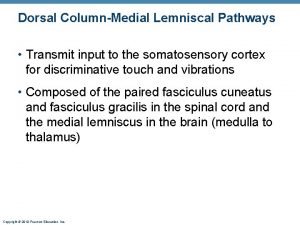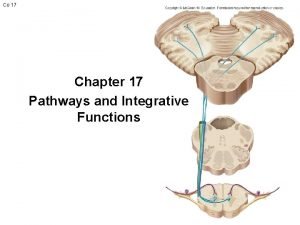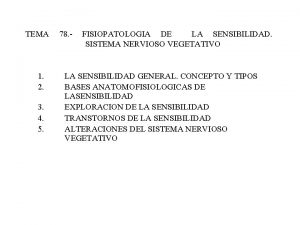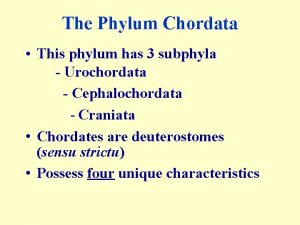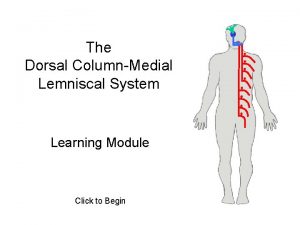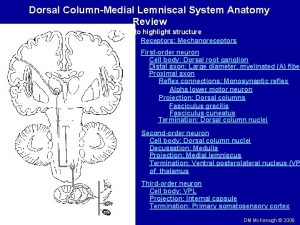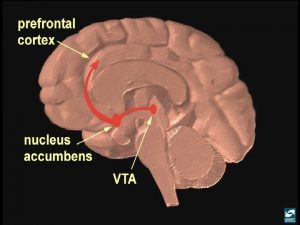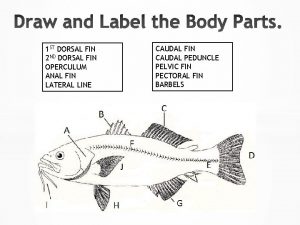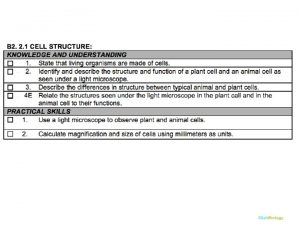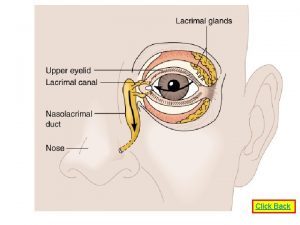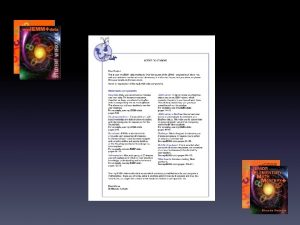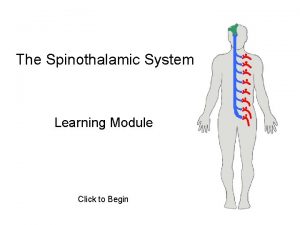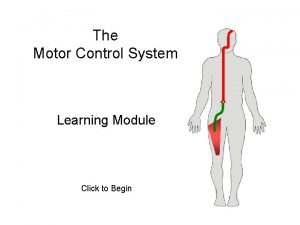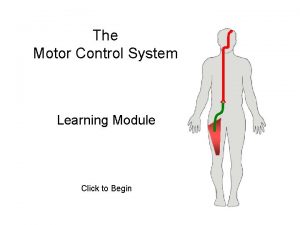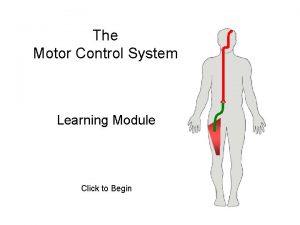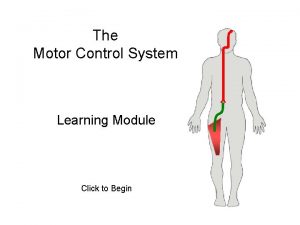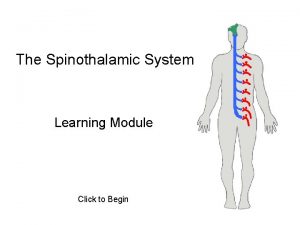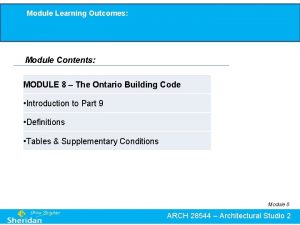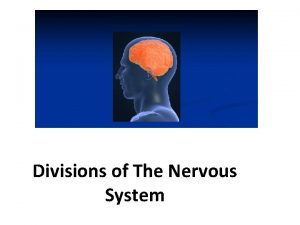The Dorsal ColumnMedial Lemniscal System Learning Module Click









































- Slides: 41

The Dorsal Column-Medial Lemniscal System Learning Module Click to Begin

Used with permission of the Academy of Neurologic Physical Therapy of the APTA Do not duplicate without acknowledging Learning Activity author Michael Mc. Keough, PT, Ed. D

Contents Overview Introduction Learning Objectives Instructions Legend Read these Instructions! Dorsal Column-Medical Lemniscal System Fasciculus gracilis Fasciculus cuneatus Lesion lessons Fasciculus gracilis lesion Fasciculus cuneatus lesion Dorsal column lesion Medial lemniscus lesion Internal capsule lesion Patient Cases Case 1 Case 2 Case 3 Contents DCML Patient Cases Lesions Exit

Overview Introduction Learning Objectives Instructions Legend Contents DCML Patient Cases Lesions Exit

Introduction • This module reviews the Dorsal Column-Medial Lemniscal System (DCML). • Module organization consists of three components. Overview consists of this Introduction and the Learning Objectives. Contents consists of Navigation Instructions, a Legend, Review of the normal structure and function of the DCML, and 5 interactive lesion lessons. Cases consists of Instructions and 3 interactive patient cases with feedback. • At the bottom of each page a navigation bar contains options to move throughout the module. • Material is presented at both the behavioral level and the neuroanatomical level. • The behavioral level is presented first and depicts a patient’s clinical presentation. • The neuroanatomical level depicts the detailed anatomy of first-order, second-order and third-order neurons. • The neuroanatomical level accounts for the patient’s behavioral presentation on examination under normal and lesioned conditions. Contents DCML Patient Cases Lesions Exit

Learning Objectives After completing this module you should be able to: 1. describe, in detail, the structure and function of the dorsal column-medial lemniscal system (fasciculus gracilis and fasciculus cuneatus). 2. given a lesion, identify the signs and symptoms that would be expected. 3. given a patient case (examination results and chief complaint), identify the location of the lesion causing the signs and symptoms. 4. correlate neurology information between the behavioral and neuroanatomical levels. Contents DCML Patient Cases Lesions Exit

Instructions • This module contains 5 interactive lesion lessons with animation. • Lesson lessons begin with a question about the symptoms produced by that particular lesion. • Clicking the answer button will reveal the answer to the question. • Clicking the explanation button will lead to both behavioral and neuroanatomical explanations of the lesion. • Each presentation is launched by clicking the animation button. The same button serves to replay the animation if desired. • Any of the 5 lessons may be accessed by simply clicking on the lesion title on the Contents page. • Please refer to the legend that defines the symbols used throughout the module. Contents DCML Patient Cases Lesions Exit

Legend Mechanism of injury First-order neuron Lesion Second-order neuron Sensory stimulus Light touch stimulus Sensory impairment Function intact Function lost Contents DCML Patient Cases Third-order neuron Lesions Exit

The Dorsal Column. Medial Lemniscal System Discriminative touch, vibration, and position information from the body is conveyed by the dorsal column-medial lemniscal system (DCML). The DCML is a crossed system. It originates from mechano-receptors (sensory receptors sensitive to mechanical deformation) located in the body wall and projects to the contralateral cerebral hemisphere via a three neuron projection system. The DCML is comprised of the fasciculus gracilis and fasciculus cuneatus. Primary sensory cortex Thalamus Nucleus Gracilis Nucleus Cuneatus Fasciculus Gracilis Fasciculus gracilis Fasciculus cuneatus Stimulus First-order neuron Second-order neuron Third-order neuron Contents DCML Patient Cases Lesions Exit

Primary sensory cortex Thalamus Nucleus Gracilis Fasciculus Gracilis: Behavioral Description Fasciculus gracilis: light touch, vibration, and position sense from the contralateral leg and lower trunk Fasciculus Gracilis Consists of a 3 -neuron projection system extending from receptors in the periphery to the primary somatosensory cortex (Click neuroanatomical explanation) Click to animate Neuroanatomical Explanation Contents DCML Patient Cases Stimulus First-order neuron Second-order neuron Third-order neuron Lesions Exit Fasciculus cuneatus

Fasciculus Gracilis: Neuroanatomical Description First-order neurons Cell body: dorsal root ganglion (DRG) Distal axon: innervates mechanoreceptors in leg and lower trunk via peripheral nerves Proximal axon: enter dorsal column (fasciculus gracilis), ascend ipsilaterally and terminate in the nucleus gracilis Second-order neurons Cell body: nucleus gracilis Axon: decussates in the medulla and projects to the contralateral thalamus (ventral posterior lateral nucleus, VPL) via the medial lemniscus Third-order neurons Cell body: VPL of thalamus Axon: ascends via the posterior limb of the internal capsule and terminates in the primary somatosensory cortex Behavioral Explanation Contents DCML Patient Cases Click to animate Lesions Exit DRG Fasciculus cuneatus

Primary sensory cortex Thalamus Fasciculus Cuneatus: Behavioral Description Nucleus Cuneatus Fasciculus cuneatus: light touch, vibration, and position sense from the contralateral arm and upper trunk Consists of a 3 -neuron projection system extending from receptors in the periphery to the primary somatosensory cortex (Click neuroanatomical explanation) Click to animate Neuroanatomical Explanation Contents DCML Patient Cases Lesions Exit Stimulus First-order neuron Second-order neuron Third-order neuron

Fasciculus Cuneatus: Neuroanatomical Description First-order neurons Cell body: dorsal root ganglion (DRG) Distal axon: innervates mechanoreceptors in arm and upper trunk via peripheral nerves Proximal axon: enter dorsal column (fasciculus cuneatus), ascend ipsilaterally and terminate in the nucleus cuneatus Second-order neurons Cell body: nucleus cuneatus Axon: decussates in the medulla and projects to the contralateral thalamus (ventral posterior lateral nucleus, VPL) via the medial lemniscus Third-order neurons Cell body: VPL of thalamus Axon: ascends via the posterior limb of the internal capsule and terminates in the primary somatosensory cortex Behavioral Explanation Contents DCML Patient Cases Click to animate Lesions Exit DRG

Lesion Lessons Fasciculus gracilis lesion Fasciculus cuneatus lesion Dorsal column lesion Medial lemniscus lesion Internal capsule lesion Contents DCML Patient Cases Lesions Exit

Lesion of the left fasciculus gracilis at T 8 produces what impairment? Click for answer Damage to the left fasciculus gracilis at T 8 causes the absence of light touch, vibration, and position sensation in the left leg and lower left trunk. Only the fasciculus gracilis exists below T 6. Click for explanation Contents DCML Patient Cases Lesions Exit

Lesion of the fasciculus gracilis on the left: Behavioral Explanation Primary sensory cortex Thalamus Nucleus Gracilis Nucleus Cuneatus Fasciculus Gracilis Sensory impairment: absence of light touch, vibration, and position sensation in the left leg and lower left trunk. Click to animate Sensory impairment: left leg and lower left trunk. Neuroanatomical Explanation Lesion Lost function Impairment Contents DCML Patient Cases Lesions Exit

Lesion of the fasciculus gracilis on the left: Neuroanatomical Explanation Because the tract has not yet decussated, impairment is ipsilateral to the lesion. Lesion of first-order neurons interrupts ascending information so light touch, vibration, and position sensation is impaired in the left leg and lower left trunk. Receptors and reflex connections below the lesion level remain intact. Click to animate Behavioral Explanation Contents DCML Patient Cases Lesions Exit

Lesion of the left fasciculus cuneatus at C 3 produces what impairment? Click for answer Damage to the left fasciculus cuneatus at C 3 causes the absence of light touch, vibration, and position sensation in the left arm and upper left trunk. Click for explanation Contents DCML Patient Cases Lesions Exit

Lesion of the fasciculus cuneatus on the left: Behavioral Explanation Primary sensory cortex Thalamus Nucleus Gracilis Nucleus Cuneatus Fasciculus Gracilis Sensory impairment: absence of light touch, vibration, and position sensation in the left arm and upper left trunk. Click to animate Sensory impairment: left arm and upper left trunk. Neuroanatomical Explanation Lesion Lost function Impairment Contents DCML Patient Cases Lesions Exit

Lesion of the fasciculus cuneatus on the left: Neuroanatomical Explanation Because the tract has not yet decussated, impairment is ipsilateral to the lesion. Lesion of first-order neurons interrupts ascending information so light touch, vibration, and position sensation is impaired in the left arm and upper left trunk. Receptors and reflex connections below the lesion level remain intact. Behavioral Explanation Click to animate Contents DCML Patient Cases Lesions Exit

Lesion of the left dorsal columns at T 2 produces what impairment? Click for answer Damage to the left dorsal columns at T 2 causes the absence of light touch, vibration, and position sensation in the left side of the body below the lesion level (trunk, arm, and leg). Click for explanation Contents DCML Patient Cases Lesions Exit

Primary sensory cortex Thalamus Nucleus Gracilis Nucleus Cuneatus Lesion of the dorsal columns on the left: Behavioral Explanation Fasciculus Cuneatus Sensory impairment: absence of light touch, vibration, and position sensation in the left side of the body below the lesion level (trunk, arm, and leg). Fasciculus Gracilis Click to animate Sensory impairment: left side of the body, below the lesion level. Neuroanatomical Explanation Lesion Lost function Impairment Contents DCML Patient Cases Lesions Exit

Lesion of the dorsal columns on the left: Neuroanatomical Explanation Because the lesion involves first-order neurons that have not yet decussated, impairment is ipsilateral to the lesion. Because both gracilis and cuneatus are damaged, light touch, vibration, and position sensation is impaired in the left trunk, leg and arm below the lesion level. Receptors and reflex connections below the lesion level remain intact. Behavioral Explanation Contents Click to animate DCML Patient Cases Lesions Exit

Lesion of the right medial lemniscus produces what impairment? Click for answer Damage to the right medial lemniscus causes the absence of light touch, vibration, and position sensation in the entire left side of the body from the neck down. Click for explanation Contents DCML Patient Cases Lesions Exit

Primary sensory cortex Thalamus Nucleus Gracilis Nucleus Cuneatus Lesion of the medial lemniscus on the right: Behavioral Explanation Fasciculus Cuneatus Sensory impairment: absence of light touch, vibration, and position sensation in the entire left side of the body from the neck down. Fasciculus Gracilis Click to animate Sensory impairment: the entire left body, from the neck down. Neuroanatomical Explanation Lesion Lost function Impairment Contents DCML Patient Cases Lesions Exit

Lesion of the medial lemniscus on the right: Neuroanatomical Explanation Because the lesion involves second-order neurons that have already decussated, impairment is contralateral to the lesion. The medial lemniscus conveys light touch, vibration, and position sensation from the entire left trunk, leg and arm below the neck. Sensation from the face is unaffected because it is conveyed via cranial nerves. Behavioral Explanation Contents Click to animate DCML Patient Cases Lesions Exit

Lesion of the right internal capsule or primary somatosensory cortex produces what impairment? Click for answer Damage to the right internal capsule or primary somatosensory cortex causes the absence of light touch, vibration, and position sensation in the entire left side of the body including the face. Click for explanation Contents DCML Patient Cases Lesions Exit

Lesion of the internal capsule or primary somatosensory cortex on the right: Behavioral Explanation Primary sensory cortex Thalamus Nucleus Gracilis Nucleus Cuneatus Fasciculus Gracilis Sensory impairment: absence of light touch, vibration, and position sensation in the entire left side of the body including the face. Click to animate Sensory impairment: the entire left body, including the face. Neuroanatomical Explanation Lesion Lost function Impairment Contents DCML Patient Cases Lesions Exit

Lesion of the internal capsule or primary somatosensory cortex on the right: Neuroanatomical Explanation Because the lesion involves third-order neurons that have decussated, impairment is contralateral to the lesion. The internal capsule conveys light touch, vibration, and position sensation from the entire left side of the body, trunk, leg, arm and face. Behavioral Explanation Contents Click to animate DCML Patient Cases Lesions Exit

Patient Cases Read these instructions! Patient Case 1 Patient Case 2 Patient Case 3 Contents DCML Patient Cases Lesions Exit

Case Instructions • These patient cases are intended to facilitate the integration and clinical application of information about the DCML by coupling the findings on examination and patient interview with their neuroanatomical correlates. • Each case begins with the patient’s chief complaint and significant examination findings. Then, the question is asked, Damage to what system(s) is causing this patient’s problems? Clicking the Answer button will reveal the answer and clicking the Show lesion button will reveal the neuroanatomic lesion along with the patient’s behavioral impairments. • Cases are presented from two perspectives. What lesion would account for a given set of examination results and patient history? For a given lesion, what signs and symptoms would be expected on examination? • Click on a Case number to begin the exercise. Contents DCML Patient Cases Lesions Exit

Case 1 Clumsiness and difficulty grasping with the left hand A left handed patient complains of “clumsiness” of her left arm and hand due to uncertainty of the limb’s position in space. She frequently fails to grasp or drops object with her left hand. Strength and AROM are WNL in all four extremities. Light touch, two-point discrimination, proprioception, and vibration sense are intact in the right upper extremity but absent in all dermatomes below the C 3 dermatome in the left upper extremity. She is able to distinguish sharp from dull WNL in all four extremities and trunk, bilaterally. Damage to what system(s) is causing this patient’s problems? Answer Lesion of the left fasciculus cuneatus at approximately C 3. Lateral corticospinal tracts are intact, bilaterally: strength and AROM are WNL in all four extremities. Lateral spinothalamic tracts are intact, bilaterally: sharp/ dull is WNL. Fasciculus gracilis is intact, bilaterally: light touch, two-point discrimination, proprioception, and vibration are WNL in bilateral lower extremities. Fasciculus cuneatus is absent on the left: light touch, two-point discrimination, proprioception (limb position in space), and vibration are absent in all dermatomes below C 3 on the left but intact on the right upper extremity. Contents DCML Patient Cases Lesions Exit Show lesion

Lesion of the fasciculus cuneatus on the left: Behavioral Explanation Primary sensory cortex Thalamus Nucleus Gracilis Nucleus Cuneatus Fasciculus Gracilis Sensory impairment: absence of light touch, vibration, and position sensation in the left arm and upper left trunk. Click to animate Sensory impairment: left arm and upper left trunk. Neuroanatomical Explanation Lesion Lost function Impairment Contents DCML Patient Cases Lesions Exit

Lesion of the fasciculus cuneatus on the left: Neuroanatomical Explanation Because the tract has not yet decussated, impairment is ipsilateral to the lesion. Lesion of first-order neurons interrupts ascending information so light touch, vibration, and position sensation is impaired in the left arm and upper left trunk. Receptors and reflex connections below the lesion level remain intact. Behavioral Explanation Click to animate Contents DCML Patient Cases Lesions Exit

Case 2: Numbness and tingling on the left side of the body Following a brainstem stroke, the patient complains of numbness and tingling on the left side of the body. Sharp/dull and temperature sensation is unimpaired, throughout. 2 point discrimination on the fingertips are: 5 mm on the right and 15 mm on the left. In the absence of vision, the patient is able to identify common objects in the right hand but not the left and able to reproduce limb positions with the right lower extremity but not the left. Light touch and vibration sensation are WNL on the right but absent on the left side of the body. Pain and temperature as well as light touch, vibration and position sense are intact on both sides of the face. Strength and AROM are WNL in all four extremities. Damage what system(s) is causing patient’s problems? Answer Lesion oftothe medial lemniscus on thethis right. Lateral corticospinal tracts are intact, bilaterally: strength and AROM are WNL in all four extremities. Lateral spinothalamic tracts are intact, bilaterally: sharp/ dull is WNL. Fasciculus gracilis is intact, bilaterally: light touch, two-point discrimination, proprioception, and vibration are WNL in bilateral lower extremities. Fasciculus cuneatus is absent on the left: light touch, two-point discrimination, proprioception (limb position in space), and vibration are absent in all dermatomes below C 3 on the left but intact on the right upper extremity. Contents DCML Patient Cases Lesions Exit Show lesion

Primary sensory cortex Thalamus Nucleus Gracilis Nucleus Cuneatus Lesion of the medial lemniscus on the right: Behavioral Explanation Fasciculus Cuneatus Sensory impairment: absence of light touch, vibration, and position sensation in the entire left side of the body from the neck down. Fasciculus Gracilis Click to animate Sensory impairment: the entire left body, from the neck down. Neuroanatomical Explanation Lesion Lost function Impairment Contents DCML Patient Cases Lesions Exit

Lesion of the medial lemniscus on the right: Neuroanatomical Explanation Because the lesion involves second-order neurons that have already decussated, impairment is contralateral to the lesion. The medial lemniscus conveys light touch, vibration, and position sensation from the entire left trunk, leg and arm below the neck. Sensation from the face is unaffected because it is conveyed via cranial nerves. Behavioral Explanation Contents Click to animate DCML Patient Cases Lesions Exit

Case 3: Multiple Sclerosis A 34 year-old Caucasian female with a six year history of Multiple Sclerosis (exacerbating-remitting) has reported to the emergency room complaining of severe symptoms. A magnetic resonance image (MRI) of her spine shows a visible plaque, not seen in previous images, at the level of T 10. The plaque involves the entire dorsal column on the left. What signs and symptoms would be expected from this lesion? Answer Lesion of the left dorsal column at T 10 would impair (in the case of a large lesion possibly obliterate) light touch, vibration, and position sensation in the left leg and lower left trunk. Only the fasciculus gracilis exists below T 6. Because she has the exacerbating-remitting type of MS, her previous symptoms will remain. If the DCML is the only system affected by this most recent exacerbation, the functions controlled by the corticospinal tract (voluntary movement) and lateral spinothalamic tract (pain and temperature sensation) would remain as before. Contents DCML Patient Cases Lesions Exit Show lesion

Lesion of the fasciculus gracilis on the left: Behavioral Explanation Primary sensory cortex Thalamus Nucleus Gracilis Nucleus Cuneatus Fasciculus Gracilis Sensory impairment: absence of light touch, vibration, and position sensation in the left leg and lower left trunk. Click to animate Sensory impairment: left leg and lower left trunk. Neuroanatomical Explanation Lesion Lost function Impairment Contents DCML Patient Cases Lesions Exit

Lesion of the fasciculus gracilis on the left: Neuroanatomical Explanation Because the tract has not yet decussated, impairment is ipsilateral to the lesion. Lesion of first-order neurons interrupts ascending information so light touch, vibration, and position sensation is impaired in the left leg and lower left trunk. Receptors and reflex connections below the lesion level remain intact. Click to animate Behavioral Explanation Contents DCML Patient Cases Lesions Exit

The End D. Michael Mc. Keough, PT, Ed. D 2015
 Spinothalamic
Spinothalamic Posterior funiculus medial lemniscal pathway
Posterior funiculus medial lemniscal pathway Supramedular
Supramedular Click clever click safe
Click clever click safe Cyber safety
Cyber safety Click clever click safe
Click clever click safe Click clever click safe
Click clever click safe Cuadro comparativo e-learning y b-learning
Cuadro comparativo e-learning y b-learning C device module module 1
C device module module 1 Chordata subphyla
Chordata subphyla Alternative learning system learning strands
Alternative learning system learning strands Hát kết hợp bộ gõ cơ thể
Hát kết hợp bộ gõ cơ thể Frameset trong html5
Frameset trong html5 Bổ thể
Bổ thể Tỉ lệ cơ thể trẻ em
Tỉ lệ cơ thể trẻ em Gấu đi như thế nào
Gấu đi như thế nào Glasgow thang điểm
Glasgow thang điểm Chúa sống lại
Chúa sống lại Môn thể thao bắt đầu bằng chữ f
Môn thể thao bắt đầu bằng chữ f Thế nào là hệ số cao nhất
Thế nào là hệ số cao nhất Các châu lục và đại dương trên thế giới
Các châu lục và đại dương trên thế giới Công thức tiính động năng
Công thức tiính động năng Trời xanh đây là của chúng ta thể thơ
Trời xanh đây là của chúng ta thể thơ Mật thư tọa độ 5x5
Mật thư tọa độ 5x5 101012 bằng
101012 bằng Phản ứng thế ankan
Phản ứng thế ankan Các châu lục và đại dương trên thế giới
Các châu lục và đại dương trên thế giới Thể thơ truyền thống
Thể thơ truyền thống Quá trình desamine hóa có thể tạo ra
Quá trình desamine hóa có thể tạo ra Một số thể thơ truyền thống
Một số thể thơ truyền thống Cái miệng bé xinh thế chỉ nói điều hay thôi
Cái miệng bé xinh thế chỉ nói điều hay thôi Vẽ hình chiếu vuông góc của vật thể sau
Vẽ hình chiếu vuông góc của vật thể sau Nguyên nhân của sự mỏi cơ sinh 8
Nguyên nhân của sự mỏi cơ sinh 8 đặc điểm cơ thể của người tối cổ
đặc điểm cơ thể của người tối cổ Thế nào là giọng cùng tên? *
Thế nào là giọng cùng tên? * Vẽ hình chiếu đứng bằng cạnh của vật thể
Vẽ hình chiếu đứng bằng cạnh của vật thể Tia chieu sa te
Tia chieu sa te Thẻ vin
Thẻ vin đại từ thay thế
đại từ thay thế điện thế nghỉ
điện thế nghỉ Tư thế ngồi viết
Tư thế ngồi viết Diễn thế sinh thái là
Diễn thế sinh thái là
